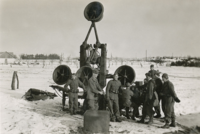Schallgeschwindigkeiten
Bildinfo und Lizenz
Bildinfo
- 1940 in Schweden: mit diesem Gerät konnten Schallquellen aus weiter Entfernung geortet werden. Man musst dabei die Geschwindigkeit des Schalls in Luft gut kennen. Ein Vorteil dieser Technik gegenüber Rad war, dass man mit Schall wegen der physikalischen Beugung auch "um die Ecke" sehen kann.
- Originalbeschriftung: Soldiers operating an acoustic airplane locator during World War 2, Trelleborg, Sweden, 1940. Before radar was invented, acoustic locator equipment was used to detect approaching enemy aircraft by listening for the sound of their engines. The detection horns were used in pairs; the side horns used for determining the bearing of the aircraft and the top and bottom horns the elevation. Each pair of horns was attached by rubber hoses to a stethoscope-type earphone worn by a technician. By rotating the horizontal and vertical axes of the horns until the aircraft sounded "centered" stereophonically in the earphones, the bearing and elevation of the aircraft could be determined.
Source
- Created: 1940
- Author: Carl Gunnar Rosborn
License
The copyright holder of this file allows anyone to use it for any purpose, provided that the copyright holder is properly attributed. Redistribution, derivative work, commercial use, and all other use is permitted.
Warranty
- No guarantee can be given as to the correctness of facts implied or explicitly stated.
- Usage is completey at your own risk. 💣
Originalseite
- Das Bild ist Teil eines online-Lexikons.
- Rhetos Lernlexikon Mathematik, Aachen:
- Siehe unter => Schallgeschwindigkeiten => lex
 1940 in Schweden: mit diesem Gerät konnten Schallquellen aus weiter Entfernung geortet werden. Man musst dabei die Geschwindigkeit des Schalls in Luft gut kennen. Ein Vorteil dieser Technik gegenüber Rad war, dass man mit Schall wegen der physikalischen Beugung auch "um die Ecke" sehen kann.
© Carl Gunnar Rosborn => Zurück zum Artikel
1940 in Schweden: mit diesem Gerät konnten Schallquellen aus weiter Entfernung geortet werden. Man musst dabei die Geschwindigkeit des Schalls in Luft gut kennen. Ein Vorteil dieser Technik gegenüber Rad war, dass man mit Schall wegen der physikalischen Beugung auch "um die Ecke" sehen kann.
© Carl Gunnar Rosborn => Zurück zum Artikel
